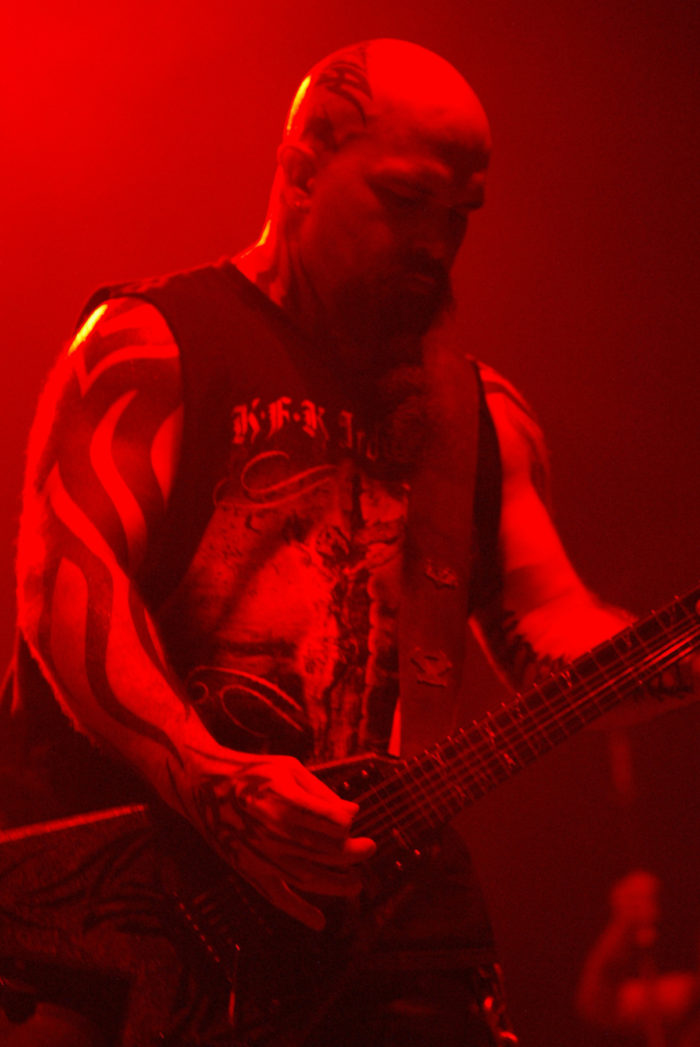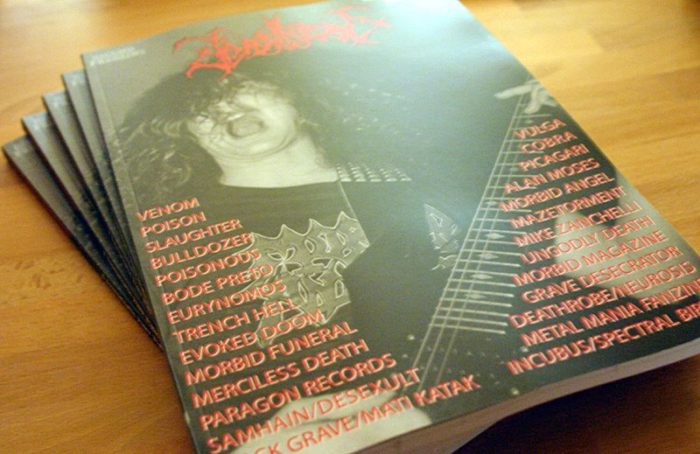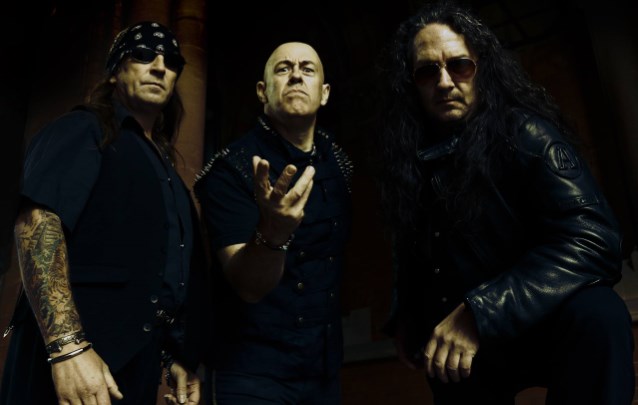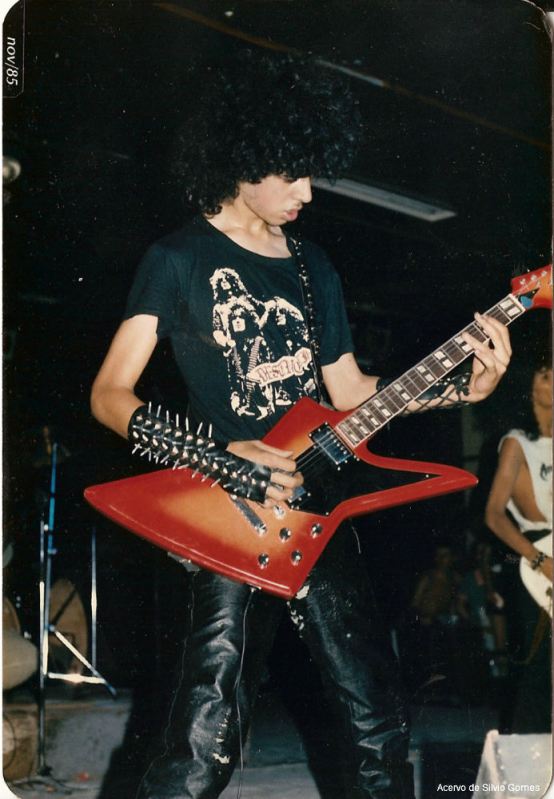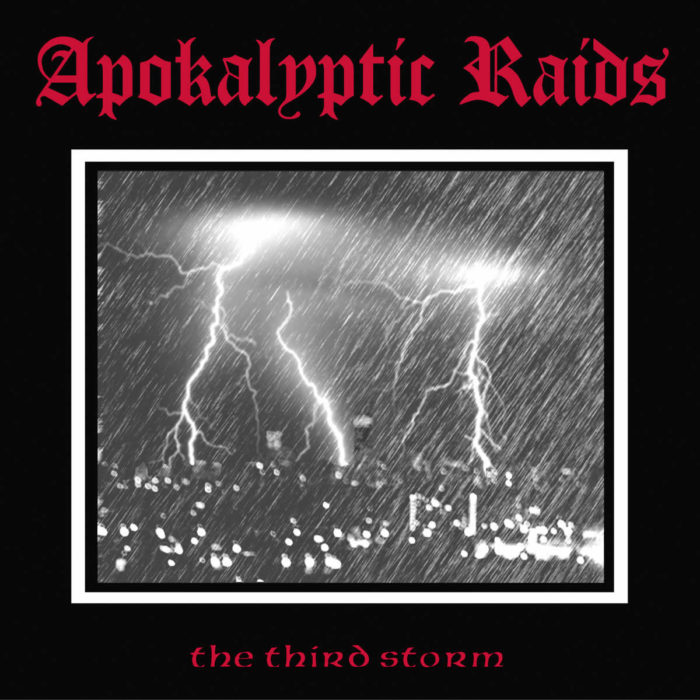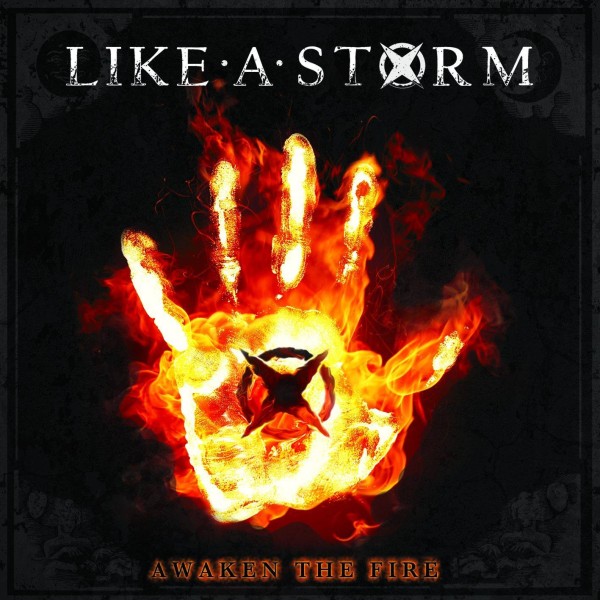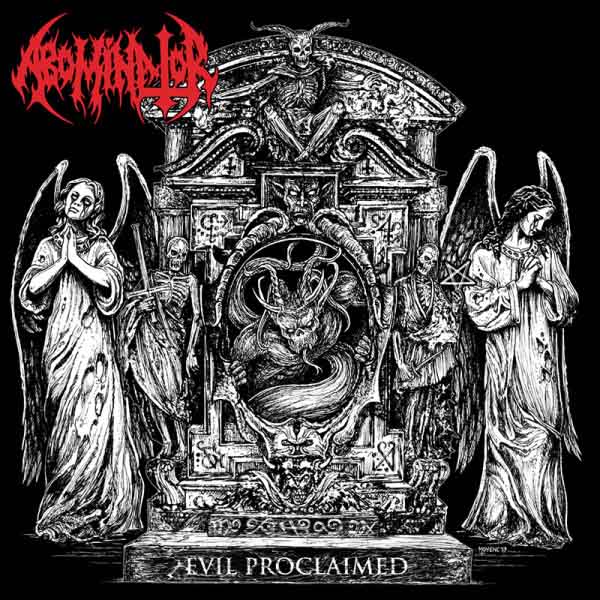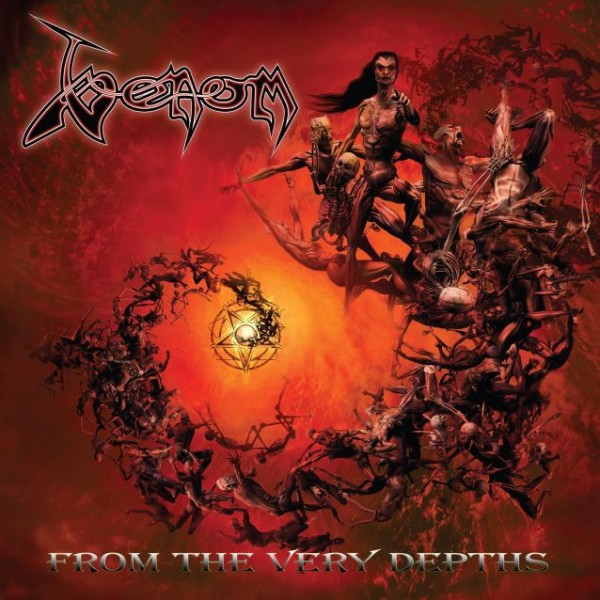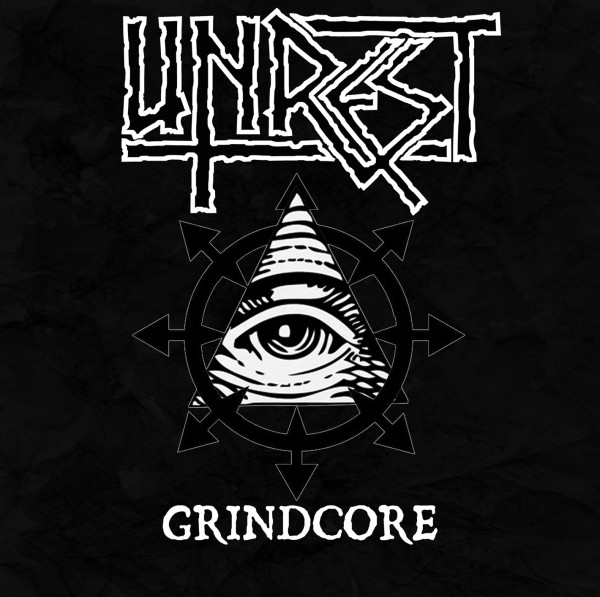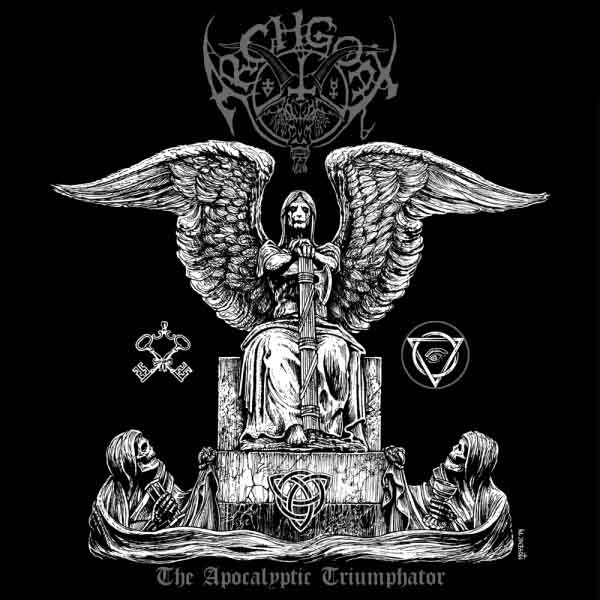
Legion of Doom – The Horned Made Flesh
LEGION OF DOOM attempt to channel later ROTTING CHRIST by becoming melodic heavy metal with ranting black metal vocals on the faster verses, but preserve their original intent and consistency over the past few albums: they compose in similar ways, but their technique and knowledge of theory has been upgraded to allow more keyboard interaction, slicker riffs, and correct approximations of some of the riff structures they must have admired in the metal that influenced them. Song structures follow patterns established on past LEGION OF DOOM albums; they are still chasing certain poetic ideas, like the complex song that culminates in a simple three-chord riff, or the slow introduction out of which builds a structural study. That being said, LEGION OF DOOM is ahead of every other oldschool Greek band because they know how to vary tempi and riff styles and are concentrating on atmosphere, which they generate in a melange of BURZUM- and EMPEROR-influenced riffs. This is far better than average for black metal of this time, but many of the old schoolers may find the “soft” aesthetic distancing.

Intestine Baalism – Ultimate Instinct
I believe form follows function but that form can have a wide range of things comfortably expressed through it. For this reason, when a band like GENERAL SURGERY or PATHOLOGIST is wholly derivative of another band’s style but also really good, it’s hard to in any way condemn them. In that sense, INTESTINE BAALISM strike me as realists who took the voice of Swedish death metal and tried to give it another life. They did, in that they’ve created a B-level SWDM offering on par with maybe INSISION or UNCANNY, borrowing liberally from UNANIMATED, CARNAGE, ENTOMBED, SACRAMENTUM and DISMEMBER to create a sound for some death metal of relatively average structure with two exceptions: most songs introduce themselves and slowly mutate their introduction riff to become the first verse riff, and many songs have melodic transitional bridges in the same way stadium heavy metal bands used to do, some featuring really brilliant guitar work. Where this CD falls down is that it tries to throw too much of the newer melodic Swedish “death metal” into the mix, and since that stuff is basically a warmed over ACCEPT/MOTLEY CRUE hybrid, you end up in hard rock territory really fast with death and speed metal riffs zinging around the room like petrified sharts.

Botch – We are the Romans
Before Botch, there was music like this, which interpreted metal riffs as a kind of carnival of opposites designed to cycle around a rock song structure. They focus on the groove that you can achieve, as avant garde jazz did, by wrapping bizarre-sounding spidery phrases around a dissonant harmony that serves as entry point to implied and indirectly stated verse and chorus. In this view, however, the metal and punk technique used by this album becomes decoration to this underlying rock music, and so while it doesn’t appear to be rock music, on the level of design/structure it is, and is correspondingly empty once you get past the fast ripped scales and emo chords unraveling into their root notes. The bounding, two-hit drumming that pervades this album underlines this basic normalcy so, like a hipster, it dresses itself up as something unique and weird but at its essence, is the same old thing given a good dose of technique. I really liked the title. Like the Candiria, Mordred, and Kong of old, however, it creates an oil-on-water separation of metal/punk from rock, and so comes apart in your hands like a boiled squishy turd. Clearly the archetype for most albums of this nature to follow, it nonetheless misses what is unique about metal and in its neurotic desperation to hide its inner humdrum normalcy, succeeds in making a mess where one did not need to be.

Father Befouled – Profano Ad Regnum
These gents try very hard to be the reincarnation of Havohej, with generous doses of early Incantation and Obituary, and come very close. Many of these riffs are note-varied or rhythm-varied interpretations of classic Havohej/Profanatica riffs, and song structures use the same simplistic, almost serial circular advance of riffs to produce a similar sense of dread. Vocals are patterned more after Incantation, and dirge material builds itself harmonically and rhythmically like early Obituary. The result is gratifying to those who want the old school sound but needs to define itself; being on the outside looking in to Paul Ledney’s vision means that we are forever getting an interpretation of an interpretation, and reality is inching away from us. After making sure we know they are trademark NYEUM (New York Esoteric Underground Metal) in the INCANTATION, REVENANT and PROFANATICA style, FATHER BEFOULED develop their own voice. On the third track, an At the Gates-ish affinity for single-note lead melodies comes in, and then on track 5 there’s a reinterpretation of Celtic Frost, and the rest of the album battles for a melodic influence that with the HAVOHEJ admixture ends up sounding like SARCOFAGO mixed with HELLHAMMER using the better technique of early INCANTATION played by a black metal band. In this style, however, Father Befouled is the best yet and what they understand that other bands do not is that songs need to be coherent wholes, where changes in riff and rhythm gesture us the listeners along to some conclusion. For that any reviewer will be vastly thankful — this disc is not random riffs — but at some point honesty compels us to tell this band to innovate its own germinal material. Clearly they have the technical and imaginative ability, and understand the “spirit” of the underground, which makes them one of the few candidates who can do this.

Darkestrah – The Great Silk Road
People are familiar with archetypes. Once they understand one of those, they can modify it. Only the best of them are able to craft a language all their own and use it to express a truth to which it is adapted. Darkestrah have mastered two arts: the art of power metal, and the art of all the trappings of a Burzum-Gorgoroth-Drudkh hybrid. They take the former and dress it up in the latter, and do it so well it takes almost halfway through the album before the veneer fades away like melting frost and the simplistic, bouncing melodies stand revealed for what they are. In a way, it reminds me of early In Battle, but more tricked out with black metal guitars and keyboards. Instrumentally very competent; artistically adrift on a sea of sewage, drinking big gulps from a cup labelled PRICELESS CHARDONNAY.

Kreator – Hordes of Chaos
What an original concept — the elites rule the earth, and so the hordes of the people will rise up and destroy them through chaos and violence and confusion — and what an original style of music to use to express it! Kreator match their signature ominous riffs, about one per song, with a vomit spew of mixed power metal, hard rock and speed metal cliches. There’s a lot of dual guitar activity in the Iron Maiden style thrown right up against later Sepultura two-chord march riffs, then some of the flamboyant lead guitar of hard rock thrown in with power metal fretwalk riffs. Does it add up to much? The first song is compelling if you listen when you’re distracted, but after that the album further lapses into genericism. The hilarious mixed metaphors cover art adds to the sense that, when one lacks forward motion, you throw everything you’ve got left into a conglomeration and duct-tape it together. For all its furious activity, this album bespeaks drained souls and energyless but resentful lives. The result for the listener is a lot of sound and fury signifying nothing.

Deathevokation – The Chalice of Ages
Every old school death metal fan would give a left testicle to like this. Killer vocals – check. Awesome title – check. Dumb band name? Skip that for now. Good guitar playing – check. Old school style, from Asphyx to Zemial, memorized? Check. What’s wrong? What’s wrong is that you cannot throw a bunch of random stuff, even in tribute to one of the greatest eras of metal, into a lattice of convenience and coincidence and expect something good to come from it. The style is roughly that of early Amorphis hybridized with later Cemetary, in that it uses melodic lead overlays on top of rushing power chord riffs and builds up to a promenade riff that trots out the inner melodicity in explicit form. It’s like later Cemetary in that cheesy hard rock, death metal, speed metal and heavy metal all take turns bleeding out from the mess, like it’s a bagfull of hostages each fighting to be heard, and the result is so random that it sounds monotone.

Amebix – Risen! promo
All the best punk bands seem to want to become metal in their more mature offerings. The most notable feature of these new Amebix tracks is that they sound like Lemmy Kilmister vocalizing over mid-paced speed metal, like Prong fused with Slayer, which aims for the theatrical impact of the bigger NWOBHM bands. Galloping muted riffs, chromatic shifts to end each bar, and short bursts of lyrics achieve this goal, aided by periodic keyboards and slower, ballad-like choruses which evolve into progressive-ish transitions. In this, Amebix are continuing the state they reached with Monolith but fulfilling it more accurately with the kind of aggression found on “Right to Rise” (off Arise!) but they’re adding more precise drumming and Slayer-styled tight control of tremolo strum to encode multiple rhythms in a phrase. Most interesting is that these effects are applied to three older songs, making them eerie as familiar sounds coalesce from a more technical and dominating assault. Look for an interesting conclusion as Amebix retrofits itself in this style for their new tour.

I Shalt Become – In the Falling Snow
When I Shalt Become first hit the scene back in 1996, he/they were almost instant celebrities because no one in the United States had yet figured out how to clone the Burzum sound and achieve that trance of dreamlike suspension of reality. ISB has mastered the technique; on their first work, “Wanderings,” ISB made half-finished sounds that took us into a vision of beauty in darkness, but had nowhere to go after that. On their second effort, nothing has changed, although technique is even more refined. It’s exactly like the first, maybe a little better, but part of what made the first charming was its unevenness into which we could read possible hope. On this CD, it’s more repetitive and that is why response has been so light.

Devastation – A Creation of Ripping Death
This is everything I hated about 1980s metal. The very block-cut basic riffs, the very obvious song direction, the vocals synchronized in rhythm to the chords of the riff, creating a cadenced shout effect like being part of a mob about to start a pogrom against smart people. Basically, it’s a lot of Slayer rhythms and ideas simplified and made catchier and a billion times more repetitive. Against all science, this recording may lower your IQ.

Krisiun – Southern Storm
More children’s music. These very simple, very obvious melodies are used to interrupt what are some pretty cool speeding riffs that go nowhere because the riffs themselves are not epic enough to give a sense of mood, and because they’re assembled in a rhythmically convenient order that gives you no sense of significance in the change between riffs and tempi. Instrumentally, this is brutal death metal not different from a faster Internal Bleeding or Malevolent Creation, with some of the chanting rhythms that made later Sepultura so obvious the band started thinking of grunge as “a breath of fresh air.” The obvious factor to these compositions is crushing, but even worse is that the band cannot confine themselves to making obvious and simple tunes, but have to try to trick it out with extensive guitar soloing and use of Meshuggah-style(tm) interruption rhythms. Kill it with fire.

Svartthron – Bearer of the Crimson Flame
I’m realizing people will claim to like just about anything because they think liking something not everyone else likes makes them cool. Either that, or they’re trying to set up random combinations of CDs so they can claim to be unique. I know intelligent people like this CD and I respect their opinion. Mine is that it is well-executed drivel, like 99% of metal. The instrumentation is great. The CD itself confuses boredom with a somber mood, and uses that as its artistic guide, producing somnolent drone or dirge material that has no animating spark or cause or worldview that makes it in any way viable, much less unique. If you’re tr00 kvlt, go buy this.

Akimbo – Jersey Shores
This album takes a covertly aggressive punk hardcore approach to a rock/post-rock hybrid, with more space given to the music where hardcore normally dominates it in washing abrasion of distorted guitar. Instead, it packs away its riffs and brings them out from the obscurity like a punch — or, staying on topic, a shark attack. Its weakness is the howling vocals which seem completely unnecessary in that they’re too constant for an album that this ambitiously hopes to use the dynamic of surge rock.

Banishment – Cleansing the Infirm
Fast brutal death metal, like later Malevolent Creation fused with Deeds of Flesh, and not bad for that. Vocalist makes the unfortunate choice to have his voice too closely follow the root notes the guitar is playing, which makes it sound like the whole band is a guitar effect. Catchy, but not particularly enlightening.

Apotheosis – Farthest From the Sun
We’ll pose a little at being epic black metal, then drop you into a Pantera riff. It’s what happens when metal loses direction; everything gets all mixed together, from Def Leppard through Graveland, and thrown into something that ends up being so generic you can listen without realizing the music is on. Skip.

Zemial – In Monumentum
Opens with one of the dumbest hard rock riffs ever, which pauses right on the bounce expectation as if it were anticipating the ears of a retard. I almost drooled. The CD continues in this direction, tossing Motorhead in with Motley Crue and Morgoth, hoping we don’t notice, but really, why would anyone listen to this when there’s AC/DC? Led Zeppelin? Even “Shout at the Devil”? It tries for evil but manages Marilyn Manson, the garage version that the hip kids like and everyone else is like whatever yo. I get the impression they’re trying to be an updated Death SS but without distinction.

Depravity – Silence of the Centuries
Finnish mid-paced melodic death metal; imagine Demigod periodically zooming into mid-period Therion and you have this interesting fusion between heavy metal and death metal. Unfortunately, a lot like Edge of Sanity, it strays too far onto the rock side of things, not understanding the geometrical language of riffs that made death metal song structures so hard to do right. It’s more like later Dio with death metal technique applied.

Unburied – Slut Decapitator
Blockhead brutal gore with a penchant for blast mania, but no real direction to these songs. Bounce, bounce, breakdown, blast, bounce, bounce, breakdown, stop. I understand the title: If you decapitate yourself with a slut, you no longer can hear this noise.

Storming Darkness – Sin-thesis
This is so much better than most of what crosses my desk I had hope despite the silly album name. It’s good. But not good enough. Repetition of melodic metal themes and a type of subtle breakdown that occurs internally to a pounding bass-snare will not do it. Nor will even the harmonically more advanced, well-played chorus passages and transitions. This really isn’t bad; unfortunately, it’s also non-distinct and directionless.

Damnation – Rebel Souls
Similar to Betrayer and Vader, this Polish death metal band fuses a number of post-1991 death metal styles into a format that is very close to Morbid Angel, but in its more “two-step” riffs, a bit more like Terrorizer. By two-step riffs I mean that there’s a phrase, and a counterphrase, and then the riff repeats until the end of a bar, when a two-chord shift turns it around; the riffing is orthogonal, unlike the geometric offsets of Morbid Angel or the even numbered structures of early Vader. Within this, there’s a lot of speeding riffs in a style eternal from Destruction through Massacra, propelled by furious battery reminiscent of Kataklysm and, at times, Deicide. Edges of Suffocation-styled palm muted blast picked death metal and double-time speed metal like later Hypocrisy intervene, but the standard is straightforward ripping death metal. Songs integrate additional riffs but remain mostly verse-chorus with transposition of early patterns into promenade riffs leading to conclusions. Like most material of this type, the constant battering becomes tiring and not exciting over repeated listens. Although this is most well-known for having members of Behemoth in the band, this album can stand on its own but is not distinctive enough for metal history to notice.

Anal Vomit – Demoniac Flagellations
Love the titles, forgot the music already. Standard grind with frenetic death metal touches, like Angelcorpse recording hurriedly in a lean-to studio outside a jail.

Urizen – Autocratopolis
Being avantgarde is easy. Combine everything that’s not popular, and make it groovy, but always do what you think is unexpected. Problem: you’ve thought two levels deep, assuming that most people think one, in a world of infinite levels. As a result, your music comes across as a childish reaction, and bears this out by being an omelette of rejected metal styles thrown together around the lowest common denominator, which is annoying pop songs given an additional level of complexity by dividing verse/chorus structure so that it recombines in a circular fashion. And we had such high hopes from the name.

Dark Fury – Fortress of Eagles
Black metal ended like WWII: after the Americans left and Central Europeans were defeated, the Eastern Europeans surged in with something that looked sort of like the functional governments that went before. In black metal, it is the same. These musicians are talented, and clearly they know their black metal, but without understanding the transcendent goal that compelled early musicians to render their vision in scratchily distorted power chords, the new bands are always outsiders looking in and then making their version. Yet like an architect who knows only how to copy facades and put them on the same boxy Soviet-era architecture, Dark Fury churn through Burzum riffs, Venomish riffs, Darkthrone trudges, and so forth, but never pull the whole thing together because there is no core to the music. It is pure aesthetics and as a result, directionless in the same way good wallpaper is: you don’t want it distracting from the action in the room.

Diabolic – Chaos in Hell/Possessed by Death
Did the completely unoriginal title clue you in? Yep, it’s a tribute to past bands that were much better by hoarding their themes, tossing them in the washing machine for recombination, and then spitting them out with the subtlety of horse rape. Metal like this causes metalheads to listen to Katy Perry.

Mirrorthrone – Gangrene
Ulver, Borknagar and Therion combine in a Summoning-themed metal band. Unfortunately, between gentle keyboard descents like the windsculpted surfaces of sand dunes, the “carnival style” post-Cradle of Filth black metal rears its ugly head as elements are thrown together in a salad of distractions from which each piece returns to a few exactly repeated themes. As a result, there’s a lot going on, like riding a merry-go-round and seeing the world outside flash by in disorienting random order, but there’s no development of theme; it’s just a more complex version of verse/chorus. I really would like to like this but it is impossible. Production and keyboard composition are excellent.

Autumn Leaves – As Night Conquers Day
Years before it became trendy, this band invented the new wave of Swedish melodic “death metal,” which of course isn’t death metal as much as, following the success of DISSECTION and UNANIMATED, melodic heavy metal with death metal vocals. You get some lovely IRON MAIDEN style dual-guitar harmony leading into a DISSECTION-esque rising melodic riff, and then drop straight into PANTERA or MESHUGGAH for a muted strum, offbeat, bouncy aggressive riff over which someone rasps like AT THE GATES. Over time, the album develops more of its melodic side, but it likes to keep that to a few variations on a theme and a contrasting chorus that uses half of the same notes. Much as the first THE ABYSS album defined a pattern for mimicking black metal, this CD defined the New Wave of Swedish Death Metal — basically melodic heavy metal with speed metal technique and death metal vocals — that aped a hybrid of SENTENCED (specifically, Amok), UNANIMATED, DISSECTION, CEMETARY and SACRAMENTUM but in cheesy, crowd-friendly heavy metal form. Better than those which followed in this style, As Night Conquers Day is both exceedingly well-executed and, because it aims for a hybrid between things popular for their unchallenging nature, a lowest common denominator assault of so many catchy things that they all equalize and you get one big unmemorable stream of noise.

Cult of Luna – Eternal Kingdom
If you apply punk rhythms to two-note power chord riffing, then add indie rock fills and metal vocals, you have Cult of Luna. This band was more inspiring when they did wash of harmonizing noise like Burzum and My Bloody Valentine, but now it’s standard saccharine dramatic indie rock which like a hipster, does a good game of raising inch-deep mystique and then vanishes around the corner, leaving a hint of promise in the air that turns to a stench of disappointment. This is a very average album dressed up as something significant and, while it executes that vision well, it leaves no lasting power or vision of life beneath the obvious, trite and controlled.

Cold Northern Vengeance – Domination and Servitude
If Maudlin of the Well had been fascinated by the black metal aesthetic, and decided to combine the quirkiness of bands like Spear of Longinus with about every metal variation of genres that have influenced metal, you would get this atmospheric and technical take on black metal. Like projects from time immemorial that have tried to throw diverse influences together and get a clear voice, it never quite gels, but that keeps its space open. There’s some nice melodies on here and songs that like most technical music, do not aim to be conclusive so much as they hope to pull together an idea from disparate origins. Like Maudlin of the Well, this is probably not for everyday listening, but will garner the appreciation of musicians. What it achieves that is most impressive is breaking the jazz-omelette barrier and making a metal-like, dark and ancient mood within so much modern musicianship.

Ecnephias – Haereticus
More vamping pseudo-Gothic keyboard-infused bouncy black metal. It has no personality at all, other than a fusion of later Cemetary with Skepticism and Dimmu Borgir, a mixture which sounds ideal but in practice cannot find common ground except on the most basic stylistic similarities. Spirit? Idea? Drive? Musically, it’s great and sometimes reminds me of later Rotting Christ. The beats are very similar and the composition staged harmonically much like the more erudite rock. But as a sum total of art, or a listening experience, it delivers nothing.

War Cry – Trilogy of Terror
Cut from much the same mould as Saint Vitus, the heavy metal musicians in War Cry make surging punk-influenced music like Venom but at a slower pace with the galloping rhythms of early speed metal like Satan and Sabbat. Interestingly, the vocalist sounds a lot like James Hetfield in both timbre and delivery. In the ways these vocals dive across large intervals and then present a sudden bittersweet melody and abrupt rhythm the band resembles Angel Witch. The usual gaggle of influences on older metal music emerge, including Iron Maiden most notably, but here it’s channeled into a style of music that hovers in the mid-paced arena but projects a somber aura like a doom band, when they’re not busy rocking out, that is. History swallows up any knowledge of where they would have taken it, but for a demo of its time, this was a solid B+.

Walpurgisnacht – Die Derwaert Gaen En Keeren Niet
Whenever metal starts a new tributary from its river of heaviness, that rivulet runs for some time and then fragments as it explores. After that, some people realize it’s a great opportunity to make a synopsis of those different directions, an opportune compromise if you will, and then norm the structure of the music back to the verse-chorus pop music of your average radio candy band for teenage brats to enjoy before life harvests them as cubicle slaves (pwnt). Some bands are smart enough to add variations like double riffs for verses, adding transitional riffs and making the bridge into a series of riffs that fit together like a telescoping umbrella before dropping you into the predictable. But it’s only a matter of time before the classic heavy metal riffs come out, along with their rock music bounce and simple-minded distraction, and in this case the transition is from Gorgoroth/Gehenna-style dark riffing to Mayhem-influenced epic pentatonics and then with a shrug straight into archetypes out of 1976 heavy metal. Of the bands out there now, this band most resembles Sammath or Fluisterwoud. Despite those additions, which end up being riff-salady, Walpurgisnacht is about blatantly sentimental melodic hooks and recurrent invocation of riffs from black metal’s history. Unlike most of its contemporaries, Walpurgisnacht has a beautiful misfortune advantage: between melodic hooks, rhythmic hooks, and pure speed/violence thrills, it’s catchy as all hell. This bestows the ultimate curse in that it both isn’t bad and isn’t inspiring at all because it too glibly speaks the language of appearance of form without altering the intelligible structure beneath.

Vomit – Rot in Hell
Jump back to 1985 or so. Stereos are blistering with Ride the Lightning and Hell Awaits. There’s no internet and metal publications are few and far between, so you get your news by dubbing a couple tracks from each of your latest finds onto cassette for your friends across the world. You spend your few bucks on postage but get more music than you could ever find in a record store or the flaky, xerox-distorted catalogs of the primitive mail-order of the time. Sound romantic? Then sign up for this hybrid of speed metal, thrash and the early death metal without death metal vocals that was Slayer. Vocal rhythms are profoundly Slayer; song structures and half the riffs are Metallica; the rest of the riffs are a meshing of the ideas behind Slayer, Sodom, Venom, Sepultura and Destruction. It’s extremely engaging music, with lots of energy and the banging of the drums, but it is like the rationalism it finds reprehensible, very fucking linear. I like it but never want to listen to it again.

Vile – Stench of the Deceased
Some albums innovate on the inside of the genre, while others take its disparate aesthetic influences and standardize them. Vile really nailed the sonic appearance of post-Cannibal Corpse death metal, complete with squeals in the Incantation style, Malevolent Creation creeping thunderous choruses, Suffocation breakdowns and windups, Immolation’s riff salad and leaps between tempi. But… this is good, but the gestalt of it is not great: in fact, as the term gestalt implies, music should give off a spirit that like an MD5 checksum gives us a single representation or shape to its direction. Here that clarity is so muddied that what we remember is a cinematic procession of riffs like a nightmare dream movie, inscrutable to those who do not know the narrative passing through the minds of these musicians. Riffs are quality but never so above the board good that they’re memorable, and their arrangements rapidly lose integrity and become a series of techniques. This is an album you will love the idea of but be unable to return to as a classic for inspiration.

Venom – Hell
I’ll give this band credit: they mixed influences, but then knew how to pick selectively the parts that work together. The first track is a Slayer rhythm with a speed metal style infectious chorus, Prong-inspired industrial noises in the background, and a Pantera-ish jaunty riff with monotone vocal deadpan. At this point in their career, Venom as musicians are slick and know the archetypes of their genre, so they pull off a very believable album to the degree that you never think to question whether this is a big band — obviously, these guys arrived long ago, and have been taking music lessons ever since. While the quality of this music is good, by aiming for the simple-minded and catchy, it sort of takes itself out of the running for contemplative profundity and in doing so, shows why Venom was a first attempt at black metal that never succeeded: it couldn’t leave the heavy metal, rock ‘n roll mentality behind. Even Sarcofago, Hellhammer, and Bathory, who I’d consider the first generation of black metal, developed themselves into art with a sense of the sublime and subtle. Venom is just like Metallica and Exodus, barging in with loud declarations where we’re supposed to assume words equal their meanings, like a reshuffling of the hippie symbolism of rock. I respect it but there’s no way in hell I’d ever reach for this CD given the other great options out there, although it’s a vast improvement on Venom’s classics, musically.

Ved Buens Ende – Coiled in Obscurity
You know what else coils in obscurity? Poop. This CD, of live and instrumental rarities by this band, showcases both what they were trying to achieve and why they were ignored by many of us. First, they’re trying to achieve what the reckless yells and blatantly ambitious singing on this CD seems to gesture at; a soul unconnected from awareness of social consequences (this is what people want when they bloviate about “freedom”). Second, the underlying Mayhem-inspired gritty but monotonous riffing shows how they hoped to achieve it, which is the same method every punk band since the dawn of time has used. Huge parts of this are blatant Burzum ripoffs with the atmosphere replaced by a sense of ashen directionless chaos. Dissonant chords howl against the grain of riffs, drums batter out something ironically confrontational, and then the track redirects itself, like the point of a pen drifting across words on a book in another language. The repetition gets old and the CD goes nowhere.

Portal – Outre
This album sounds to me like airplanes zooming over battleships. Their distortion is intensely melodic and they tend to use diminished melodies and abrupt tempo changes, drones zooming into abrupt, jazz-style recursions. In many ways, it’s a lot like what Molested tried to do, except the songs go nowhere. They thrash between different patterns that are marginally related and create a dark atmosphere, but then it doesn’t change, and so what ends up happening is that songs become monolithic and uninspiring. It’s an interesting concept, the idea of removing dynamics from the music except as a rhythm, and inserting small themes within larger patterns, but when it does not reveal any clarity to its changes, the result is like driving around in a maze with the heater on.

Rotten Sound – Exit
People were telling me this was death metal, but in reality, it’s a punk album with blastbeat drums and modified d-beat. It’s not bad but it’s not distinct enough from later Impaled Nazarene or Disfear to really care. They keep the energy going as if they’re afraid to slow down and make sense of their songs, which are two or three riffs and sometimes a tempo change. This stuff is kind of neat but one dimensional, reminiscent of Driller Killer in the way it uses very similar beats and transitions, and so sounds like one continuous linear riffing party with a variation on Swedish d-beat essentials. It’s unclear to me why anyone with access to Discharge, the Exploited and Dead Infection would choose this lesser variation.

Wolves in the Throne Room – Malevolent Grain
Having been a fan of Two Hunters for some time, this reviewer was excited to download and un-RAR the latest from Wolves in the Throne Room, one of black metal’s more successful acts. Soaring drones lace themselves over bracketing drums, and female vocals and black metal rasps guide these songs through mostly extended verse-chorus patternings, with a few discursive flights of fancy leading away and then returning. This is not an album for people who like black metal; it’s an album for people who want black metal to be what they like. Specifically, it’s a studied combination of indie rock, emo punk, crustcore and doom metal, most notably borrowing from Skepticism and Satyricon. It makes itself obvious in the protest rock style of clearly identifying what it complains about — GM crops (author’s opinion on this issue is irrelevant; this is a music review) — and makes that topic safe by construing it in the same Good and Evil game that Christianity likes to play, where moral absolutes are used to control the masses so no one has to think. There are black metal technique additions, for sure, but the spirit is mournful and poignant in that simple way that rock music makes you see a “I love her, but can’t have her, because she’s no good for me, but the sex is great” dual binary complexity to life. Unlike great art, this album never creates the chiasmus, where the opposite pairs recombine and a truth is distilled. Like Velvet Caccoon, the last great Northwest black metal phenomenon, Wolves in the Throne Room carefully study their quarry and put together a compilation of what has worked for indie rock tinged black metal for the past decade, but in doing so, they somehow lose their soul, which is borne out in the music that wanders yet not only never arrives but never decides where to go — it wallows in its opposition, like a surly priest fulminating in frustration beneath a rotting church.
No CommentsTags: Akimbo, amebix, Anal Vomit, Apotheosis, Autumn Leaves, Banishment, botch, Cold Northern Vengeance, Cult of Luna, Damnation, Dark Fury, Darkestrah, Deathevokation, Depravity, Devastation, Diabolic, Ecnephias, Father Befouled, I Shalt Become, Intestine Baalism, kreator, Krisiun, Legion of Doom, Portal, Rotten Sound, sadistic metal reviews, Storming Darkness, Svartthron, Unburied, Urizen, Ved Buens Ende, venom, Vile, Vomit, Walpurgisnacht, war cry, wolves in the throne room, zemial

